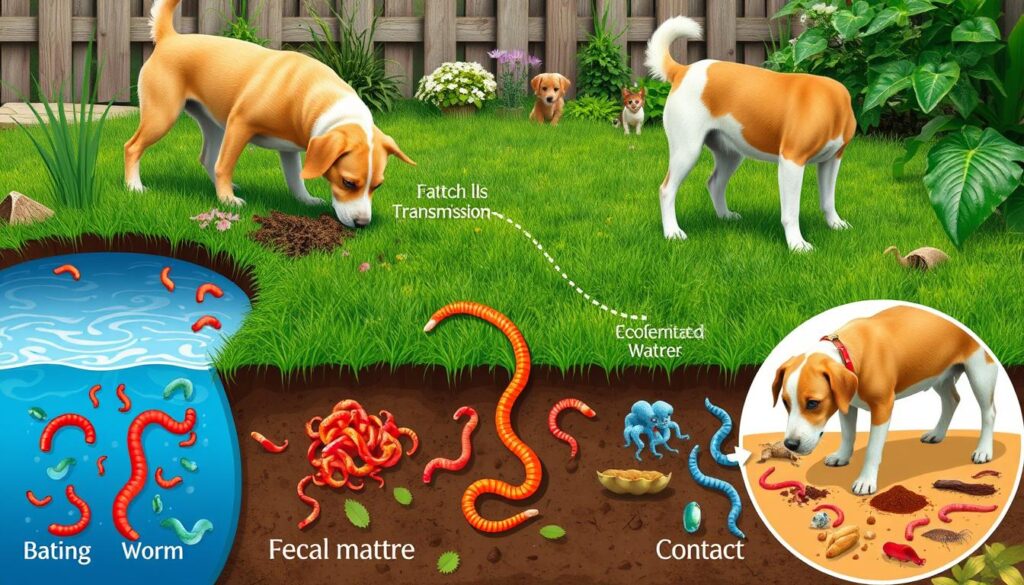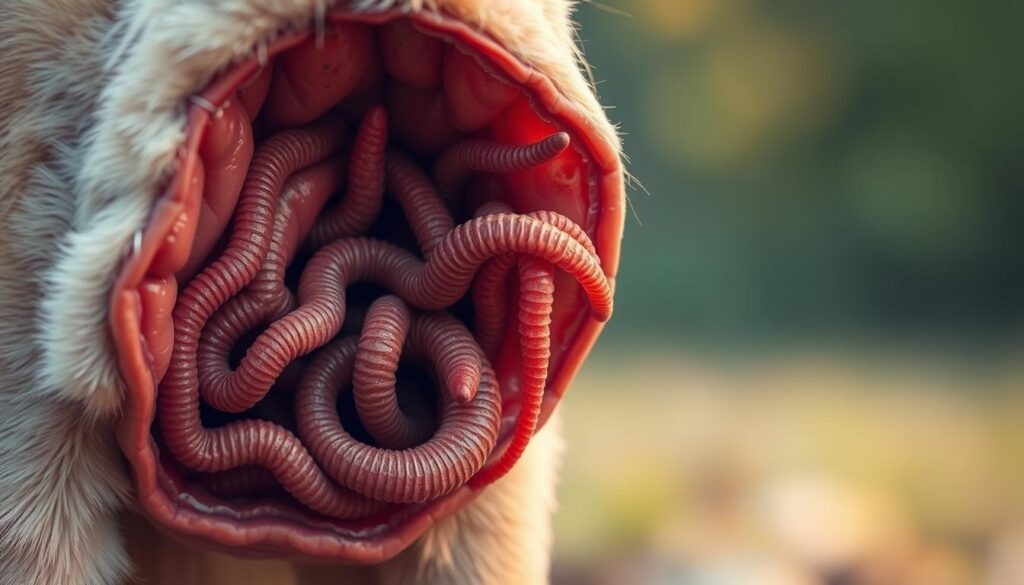As a devoted dog parent, the thought of your furry companion having worms is scary. But, knowing the signs and taking action can help keep your pup healthy. This guide will cover common dog worms, how to spot them, and how to protect your dog.
Worms are common in dogs, with roundworms, hookworms, whipworms, and tapeworms being the most common. These parasites live in your dog’s digestive system, taking nutrients and harming their health. Some worms, like roundworms and hookworms, can also infect humans, putting your family at risk.
Table of Contents
Understanding Worms in Dogs: An Overview
Parasitic worms are a big health worry for dogs. They live inside the dog’s body and eat their nutrients. This can lead to serious health problems. It’s important to know about the different worms, their signs, and how to stop and treat them.
What Are Parasitic Worms?
Parasitic worms live inside dogs, mostly in their digestive system. The main types are roundworms, hookworms, whipworms, tapeworms, and heartworms. These worms can make dogs very sick, from not getting enough nutrients to organ damage and even death.
Why Worms Are Dangerous for Dogs
Worms can be very harmful to dogs. They take away nutrients, causing malnutrition and weight loss. Some worms can also hurt organs and cause serious problems. Plus, worms like hookworms and roundworms can spread to people, putting everyone at risk.
Impact on Dog Health
Worms can really hurt a dog’s health. Signs include lethargy, changes in appetite, diarrhea, vomiting, and a dull, unkempt coat. In bad cases, worms can damage organs, cause anemia, and be life-threatening. It’s key to catch and treat worms early to keep your dog healthy.
| Common Types of Worms | Symptoms | Transmission | Impact on Dog Health |
|---|---|---|---|
| Roundworms | Diarrhea, vomiting, weight loss, pot-bellied appearance | Ingestion of contaminated soil, feces, or prey animals | Malnutrition, intestinal blockage, organ damage |
| Hookworms | Anemia, diarrhea, weight loss | Skin penetration, ingestion of contaminated soil or feces | Anemia, intestinal bleeding, organ damage |
| Whipworms | Bloody diarrhea, weight loss | Ingestion of contaminated soil or feces | Chronic inflammation, dehydration, nutrient deficiency |
| Tapeworms | Visible segments in stool, weight loss, increased appetite | Ingestion of infected fleas or prey animals | Malnutrition, intestinal blockage |
| Heartworms | Lethargy, exercise intolerance, weight loss | Mosquito bites | Heart and lung damage, life-threatening complications |
Common Types of Worms That Affect Dogs
Dogs can get many kinds of worms. Each has its own life cycle and health effects. The main worms are roundworms, hookworms, tapeworms, whipworms, and heartworms.
Tapeworms are common in dogs. Dogs get them from eating fleas with tapeworm eggs. You can see these worms as rice-like things around the dog’s anus or in their poop. Deworming medicine treats tapeworms, and they don’t spread to people.
Roundworms can be very dangerous, especially for puppies. Hookworms can make dogs weak and malnourished. Heartworms can harm the heart and even be deadly if not treated.
| Worm Type | Transmission | Health Impacts |
|---|---|---|
| Roundworms | Ingestion of eggs, larvae in soil | Serious infection, potentially fatal in puppies |
| Hookworms | Skin penetration, ingestion of larvae | Weakness, malnutrition, death in puppies |
| Tapeworms | Ingestion of fleas carrying eggs | Segments visible in stool or around anus |
| Whipworms | Ingestion of eggs in contaminated soil | Chronic diarrhea, weight loss |
| Heartworms | Mosquito bites | Heart dysfunction, potentially fatal |
Knowing about worms is key for dog owners. It helps them spot signs and get treatment fast. Deworming and prevention keep dogs healthy.
How Can You Tell If Your Dog Has Worms
It’s key to spot dog worm symptoms for your dog’s health. Some signs of worms in dogs are clear, but others are not. Knowing the signs helps you keep your dog healthy.
Physical Symptoms to Watch For
Weight loss, even with a big appetite, is a common sign. You might also see a bloated belly, diarrhea, and vomiting. Lethargy and a dull coat are other signs.
Behavioral Changes
Behavior changes can also hint at worms. Look for changes in appetite and “scooting” behavior. This is when your dog drags its rear on the ground.
Visual Signs in Stool
Checking your dog’s stool is the best way to find worms. Look for rice-like or spaghetti-like segments. Blood in the stool could mean hookworms.
Some dog worm symptoms are not easy to see. Regular vet visits and stool tests are key to keeping your dog healthy.
Transmission Methods: How Dogs Get Infected
It’s important to know how worm infection in dogs happens to stop and manage it. Dogs can get worms by eating contaminated soil, feces, or infected animals. They can also get worms from their mother’s milk or before they are born.
Hookworms can enter a dog’s skin, and tapeworms can infect dogs through fleas. Dogs get infected when they groom and eat the fleas. Heartworms are mainly spread through mosquito bites, which can be deadly.
Knowing how worms spread is key to keeping dogs healthy and worm-free. Regular vet visits, deworming, and keeping the environment clean are important. These steps help prevent dog worms.

Pet owners can protect their dogs by understanding how worms spread. Keeping things clean, watching for signs of infection, and following vet advice are crucial. This helps keep dogs safe from worms.
Understanding Roundworm Infections
Roundworms are common parasites in dogs. They can make dogs look pot-bellied, affect their growth, and cause vomiting. It’s important to know how to spot, treat, and prevent roundworm infections to keep your dog healthy.
Symptoms of Roundworms
Dogs with roundworms may show these signs:
- Pot-bellied appearance
- Poor growth or weight loss
- Vomiting, sometimes with worms visible
- Diarrhea
- Lethargy and weakness
Treatment Options
If your dog has roundworms, your vet will give deworming meds. These meds are safe and work well. It’s key to follow your vet’s advice and finish the treatment to get rid of all worms.
Prevention Methods
Stopping roundworm infections in dogs is vital. Here are some ways to do it:
- Regular deworming, especially for puppies and pregnant dogs
- Keeping a clean environment, including removing dog waste quickly
- Using heartworm preventatives that also fight roundworms
- Getting regular fecal exams to catch and treat infections early
Knowing how to spot, treat, and prevent roundworms helps keep your dog healthy and worm-free.
Hookworms and Their Impact on Dog Health
Hookworms are a big worry for dog owners. They can really hurt your dog’s health. These worms attach to the intestines and suck your dog’s blood. This can lead to anemia, especially in puppies.
Some signs to look out for include pale gums, weakness, and bloody diarrhea. Hookworms can also go through your dog’s skin, causing more problems. In fact, roughly 400 to 450 million people globally are infected with hookworms.
To treat hookworms, vets give special deworming meds. But stopping them before they start is key. This means regular deworming, staying away from dirty places, and keeping your dog’s area clean.
Some monthly heartworm preventatives also protect against hookworms. This makes them a great part of your dog’s health plan. By knowing about hookworms and acting early, you can keep your dog happy and healthy.

Identifying Tapeworm Infections
If your dog has tapeworms, you’ll notice some signs. Tapeworms in dogs show up as rice-like segments in their stool or around their anus. These segments, called proglottids, have eggs and can stick to their fur near the back.
Dogs get dog tapeworm symptoms by eating infected fleas or small animals like rodents. Besides the visible signs, they might drag their backside on the ground. This is because they’re trying to get rid of the discomfort.
Visual Signs
- Rice-like segments in dog’s stool or around the anus
- Proglottids (egg-containing tapeworm segments) visible in fur near the rear end
Risk Factors
- Ingesting infected fleas while grooming
- Consuming small prey animals, such as rodents, that harbor tapeworms
- Exposure to areas contaminated with tapeworm eggs or infected feces
If you think your dog has tapeworms, call your vet right away. They can diagnose and treat canine tapeworms. With the right care, your dog will be healthy and happy again.
The Dangers of Heartworm Disease
Heartworm disease is a serious and potentially fatal condition that affects dogs across the United States. It is spread by mosquitoes. Heartworms can live in a dog’s heart and lungs, causing many problems and, in severe cases, heart failure.
Canine heartworm symptoms include coughing, not wanting to exercise, and losing weight. If not treated, the disease can get worse fast, threatening a dog’s life. It’s very important to prevent heartworm disease in dogs because treatment is long, expensive, and risky.
But, preventing heartworms is very effective if owners use monthly preventatives. It’s also key to test dogs annually. This helps catch the disease early, which improves treatment chances. Heartworm disease is common in warm, humid places but can happen anywhere in the country. So, all dog owners need to stay alert.
- Heartworm disease is caused by parasitic worms that live in a dog’s heart and lungs
- Symptoms include coughing, exercise intolerance, and in severe cases, heart failure
- Treatment is complex, lengthy, and risky, underscoring the importance of prevention
- Monthly preventatives and annual testing are highly effective at stopping this disease
- Heartworm disease is found in all 50 U.S. states, requiring year-round vigilance
By understanding the dangers of heartworm disease in dogs and taking proactive steps to prevent it, pet owners can safeguard their canine companions. This way, they can avoid the costly and potentially life-threatening consequences of this insidious disease.
When to Contact Your Veterinarian
If you think your dog might have worms, call your vet right away. Dog worm symptoms can be mild or serious. Quick action is important to avoid big health problems.
Emergency Warning Signs
Some signs need vet help fast. These include:
- Pale gums
- Weakness or lethargy
- Bloody or mucus-laden stool
These signs might mean something serious like bleeding in the intestines or anemia. Don’t ignore them.
What to Bring to Your Vet Visit
When you go to the vet for dog worm symptoms, bring a fresh stool sample and any worms you’ve seen. Talk about your dog’s symptoms, what they eat, and any recent activities. Giving your vet all the details helps them find the right treatment.
Acting fast is key to treating worms in dogs. By being alert and knowing when to see vet for worms, you can keep your dog healthy for a long time.
Diagnostic Methods and Testing
Vets use several ways to find worms in dogs. They often look at your dog’s fecal samples under a microscope. This helps spot worm eggs or larvae in the stool.
But, worm eggs aren’t always found. So, it might take more than one sample to be sure. Sometimes, blood tests or scans are needed to find heartworms or other parasites.
- Fecal testing for dog parasites is the main way to find worms like roundworms and tapeworms.
- Heartworm testing is a simple blood test to see if your dog has heartworms.
- Whipworms can be hard to find with just one fecal test. You might need to test again.
Even if your dog seems fine, it’s good to check for worms regularly. This helps catch problems early and keeps your dog healthy. It also stops worms from causing bigger issues later on.
| Diagnostic Method | Purpose | Limitations |
|---|---|---|
| Fecal examination | Detect intestinal worm eggs or larvae | Inconsistent shedding may require multiple samples |
| Heartworm testing | Identify the presence of heartworm parasite | Blood test may not detect early-stage infections |
| Additional tests (blood work, imaging) | Identify certain parasites or rule out other conditions | May be necessary for specific cases or types of worms |
Prevention Strategies and Regular Maintenance
To keep your dog worm-free, you need a solid plan. Use monthly preventatives that fight many parasites, like heartworms. These can be given orally or as a topical, keeping your dog safe from various worms.
Monthly Preventatives
Talk to your vet about the right preventative for your dog. Consider their age, breed, and how they live. Always give the preventative as directed to keep your dog healthy.
Environmental Control
Keeping your dog’s area clean is key. Always pick up and throw away their poop, as it can have worm eggs and larvae. Also, controlling fleas is important, as they can spread worms.
Regular Check-ups
Annual vet visits and parasite tests are vital. Your vet can set up a deworming plan for your dog. This keeps them healthy and worm-free. Teach your family how to stay clean to avoid getting worms from your dog.

